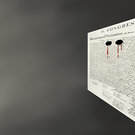Illuminating with the glow of a stained-glass past and the diodes of a cold, clear future
We made our first trip to the Troy Public Library this week. Awe is not too strong a word to describe our reaction to that temple for books. We sat at a long oak table under the warm glow of light filtered through a Tiffany window.
The scene portrays the 15th-Century Venetian master printer and scholar, Aldus Manutius. He was part of a revolution — a revolution with a soundtrack of rustling paper, not exploding cannon-fire — that made books widely available.
Aldus adopted the octavo format to secular texts so that books could be printed inexpensively. They became widely circulated. This changed the very fabric of society — people could educate themselves and advance through learning.
With an amber glow as a backdrop, Aldus, in the stained–glass window scene, presents proof sheets of an octavo edition of Dante’s Divine Comedy
All around us, people — young and old, black and white, noisy and quiet — read books or used computers.
My Enterprise colleagues and I were there to meet a recent RPI graduate who was taking our ideas for a newspaper website and turning them into a reality. In this shrine for books, we huddled about his laptop.
The irony was not lost on me. But I saw a deeper relevance in our working in the glow of that stained-glass window. The current generation is in the midst of a revolution, too. Just as Aldus, through new technology, was part of the revolution that spread knowledge far and wide to places it had not before reached, so, too, is the Internet changing the fabric of society, with an even further reach.
Back in our Altamont newsroom this week, I inhaled the familiar smell of ink and heard the rhythms of the press below me as our publisher, a master printer, went about his daily work. He is stretching and we are, too, to further our reach on the Internet while preserving our heritage.
The reach is far and random. A man I never met e-mailed me today to see if I could read a book he’s writing. He said he felt he knew me, having read my words.
Soon after, I received an e-mailed missive from the curator of Altamont’s museum. Marijo Dougherty has spent a year researching the life of an Altamont resident, Stephen A. Venear. The story of her research shows the way the printed-on-paper past can meld with the modern, across-the-world digital communication in a useful way.
The story starts with Dougherty’s curiosity. She noticed a box labeled “Russia” on a shelf in the museum and thought it must contain souvenirs of a long-ago visit. “I hadn’t gotten to all the boxes,” she said, of her efforts to catalogue and organized the massive collection. “When I opened it up, I couldn’t believe it.”
Inside were scrapbooks filled with stunning black-and-white photographs — of near-starving children and of immaculate cafeterias where they were being fed. In the box, too, were medals, very impressive medals — from the American Red Cross, from Constantinople, from the Russian Army.
Here was physical evidence, here were written words that hinted, tantalized, of a fascinating life.
How did Dougherty begin to solve the mystery, to put the pieces together?
“I didn’t know much about the starvation after World War I,” she said. “I went on the Internet to look up Crimea. I came across this book (The Big show in Bololand: The American Relief Expedition to Soviet Russia in the Famine of 1921 by Bertrand Patenaude) and got in touch with the professor at Stanford.”
The story unfolded from there — and can be read this week in our opinion pages as well as online — about the man many in Altamont knew only as the village pharmacist.
After using the Internet to reach out in her research, Dougherty went full circle, making sure that the Hoover Institute now has copies of the documents from the Altamont trove to further others’ research.
I have before me, as I write this, a beautifully hand-lettered thank-you to Captain Venear, signed on the back by grateful refugees at Anitigone. They write, “The noble way in which you have come forward, understood us, and helped us to bear our adversity will never be forgotten.”
That fragile piece of paper, with its colorful drawing of a kerchiefed country girl, carries more meaning than, say, a texted message, quick to disappear. Yet it can be preserved and transmitted though digital technology.
As we move forward in this brave new world that has such capabilities in it, our goal should be to preserve and expand what is best in humankind — to keep the personal connection that builds community while sharing information that can enlighten all.
In a corner of the Tiffany glass window in the Troy library is this quotation from a man known as the last scholar of the ancient world, Isidore of Saville, “Study as if you were to live forever and live as if you were to die tomorrow.”
We think that is good advice for any age.
—Melissa Hale-Spencer

